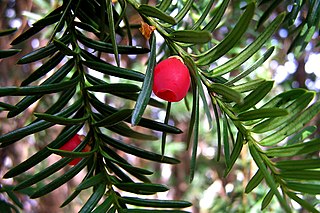
Taxaceae, commonly called the yew family, is a coniferous family which includes six extant and two extinct genera, and about 30 species of plants, or in older interpretations three genera and 7 to 12 species.
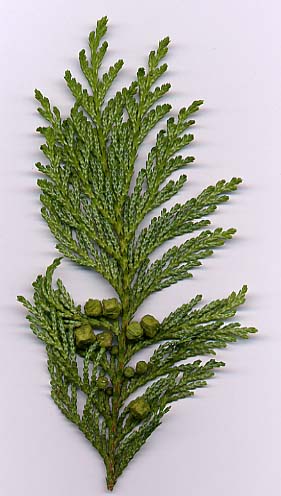
Chamaecyparis, common names cypress or false cypress, is a genus of conifers in the cypress family Cupressaceae, native to eastern Asia and to the western and eastern margins of the United States. The name is derived from the Greek khamai (χαμαί), meaning "on the earth", and kuparissos (κυπάρισσος) for "cypress".

Sciadopitys verticillata, the kōyamaki or Japanese umbrella-pine, is a unique conifer endemic to Japan. It is the sole living member of the family Sciadopityaceae and genus Sciadopitys, a living fossil with no close relatives. The oldest fossils of Sciadopitys are from the Late Cretaceous of Japan, and the genus was widespread in Laurasia during most of the Cenozoic, especially in Europe until the Pliocene.
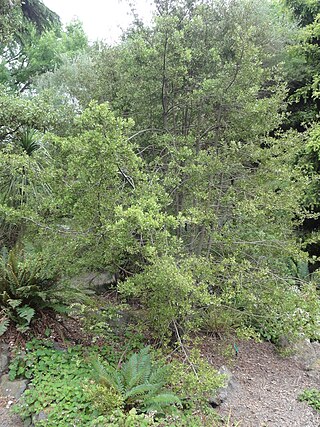
Phyllocladus, the celery pines, is a small genus of conifers, now usually placed in the family Podocarpaceae.Species occur mainly in New Zealand, Tasmania, and Malesia in the Southern Hemisphere, though P. hypophyllus ranges into the Philippines, a short way north of the equator.

Calocedrus, the incense cedar, is a genus of coniferous trees in the cypress family Cupressaceae first described as a genus in 1873. Three species are native to eastern Asia and one to western North America.

Nageia is a genus of conifers belonging to the podocarp family Podocarpaceae. Nageia includes evergreen shrubs and trees, from one to 54 meters in height. A 2009 treatment of the genus recognized five species. Some authors consider Nageia formosensis to be a separate species from Nageia nagi, thus recognizing six species. The podocarp genera have been reshuffled by various botanists. Most recently, several species formerly classed as Nageia were moved to the new genus Retrophyllum, while Nageia falcata and Nageia mannii were moved to the new genus Afrocarpus.

Afrocarpus is a genus of conifers of the family Podocarpaceae. Two to six species are recognized. They are evergreen trees native to Africa. Afrocarpus was designated a genus in 1989, when several species formerly classified in Podocarpus and Nageia were reclassified.
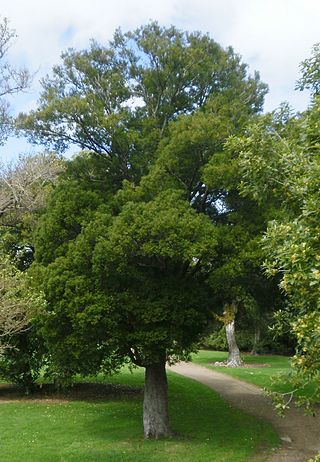
Prumnopitys is a genus of conifers belonging to the family Podocarpaceae. The nine recognized species of Prumnopitys are densely branched, dioecious evergreen trees up to 40 metres in height.

Dacrycarpus is a genus of conifers belonging to the family Podocarpaceae. The genus includes nine species of dioecious evergreen trees and shrubs to 55–60 metres (180–197 ft) in height.

Lepidothamnus is a genus of conifers belonging to the podocarp family Podocarpaceae. The genus includes three species of dioecious or monoecious evergreen trees and shrubs, and creepers. L. intermedius and L. laxifolius are native to New Zealand. L. fonkii is native to the Magellanic subpolar forests ecoregion of southern Argentina and Chile, where it grows as a low shrub or creeper in moorlands and bogs.
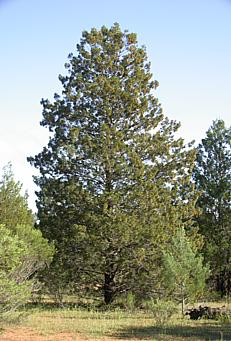
Callitris is a genus of coniferous trees in the Cupressaceae. There are 16 recognized species in the genus, of which 13 are native to Australia and the other three native to New Caledonia. Traditionally, the most widely used common name is cypress-pine, a name shared by some species of the closely related genus Actinostrobus.

Keteleeria is a genus of three species of coniferous trees in the family Pinaceae first described as a genus in 1866.

Torreya is a genus of conifers comprising six or seven species placed in the family Taxaceae, though sometimes formerly placed in Cephalotaxaceae. Four species are native to eastern Asia; the other two are native to North America. They are small to medium-sized evergreen trees reaching 5–20 m, rarely 25 m, tall. Common names include nutmeg yew.

Athrotaxis is a genus of two to three species of conifers in the cypress family, Cupressaceae. The genus is endemic to western Tasmania, where they grow in high-elevation temperate rainforests.
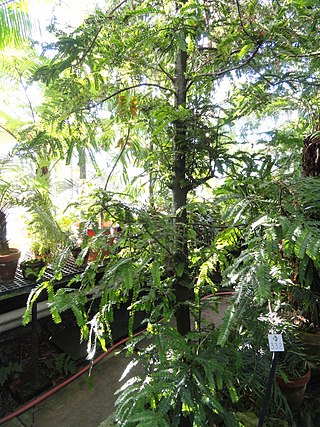
Retrophyllum is a genus of conifers in the family Podocarpaceae. It contains five generally recognized extant species with a disjunct distribution in the Southern Hemisphere, found in Papuasia and also in South America. Retrophyllum are evergreen trees typically occurring in tropical rainforests and cloud forests.

Amentotaxus is a genus of conifers (catkin-yews) comprising five species, treated in either the Cephalotaxaceae, or in the Taxaceae when that family is considered in a broad sense. The genus is endemic to subtropical Southeast Asia, from Taiwan west across southern China to Assam in the eastern Himalaya, and south to Vietnam. The species are evergreen shrubs and small trees reaching 2–15 m tall.
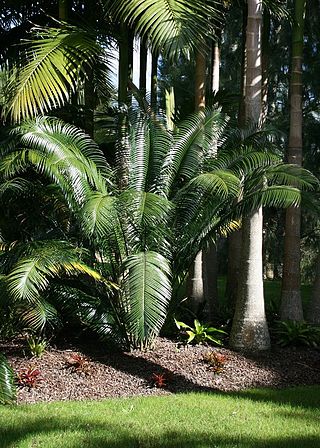
Lepidozamia is a genus of two species of cycad, both endemic to Australia. They are native to rainforest climates in eastern Queensland and eastern New South Wales. They have a diploid chromosome number of 2n = 18.
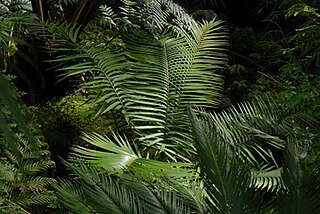
Ceratozamia is a genus of New World cycads in the family Zamiaceae. The genus contains 27 known currently living species and one or two fossil species. Most species are endemic to mountainous areas of Mexico, while few species extend into the mountains of Guatemala, Honduras and Belize. The genus name comes from the Greek ceras, meaning horn, which refers to the paired, spreading horny projections on the male and female sporophylls of all species.

Hesperocyparis is a genus of trees in the family Cupressaceae, containing North American species otherwise assigned to the genus Cupressus. They are found throughout western North America. Only a few species have wide ranges, with most being restricted-range endemics.
It is suggested a late Pliocene age (Reuverian) for this flora. Palynofloras from drill cores in the surroundings of Frankfurt am Main and Hanau also suggests a late Pliocene age. The Pliocene flora of Frankfurt am Main described by Karl Mädler during the first half of the twentieth century is a key flora for the European Pliocene.




















